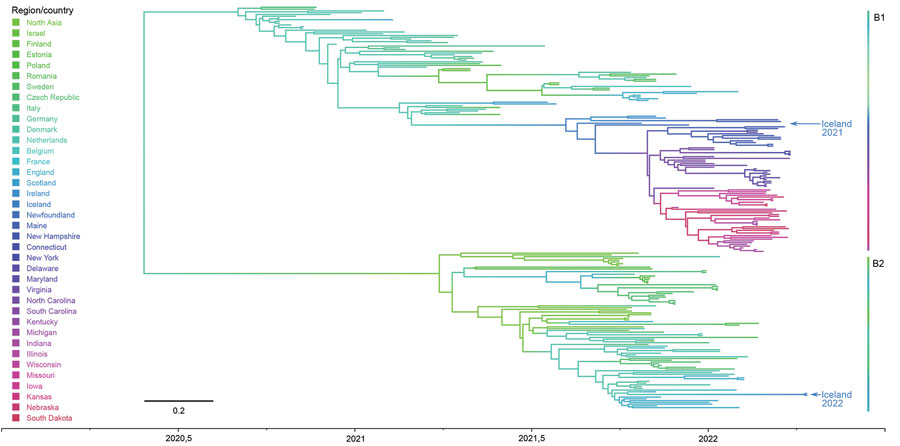Volume 28, Number 12—December 2022
Synopsis
Iceland as Stepping Stone for Spread of Highly Pathogenic Avian Influenza Virus between Europe and North America
Figure 2

Figure 2. Phylogeographic tree of highly pathogenic avian influenza viruses. Taxa are colored according to their country of origin, and countries are arranged in geographic order from east to west. Arrows indicate viral genomes during 2021 and 2022 in Iceland and assigned to different hemagglutinin clusters B1 and B2. Method hints and basic data are presented in Hassan et al. (13). Scale bar indicates nucleotide substitutions per site.
References
- Lee DH, Criado MF, Swayne DE. Pathobiological origins and evolutionary history of highly pathogenic avian influenza viruses. Cold Spring Harb Perspect Med. 2021;11:
a038679 . DOIPubMedGoogle Scholar - Dhingra MS, Artois J, Dellicour S, Lemey P, Dauphin G, Von Dobschuetz S, et al. Geographical and historical patterns in the emergences of novel highly pathogenic avian influenza (HPAI) H5 and H7 viruses in poultry. Front Vet Sci. 2018;5:84. DOIPubMedGoogle Scholar
- Lee DH, Torchetti MK, Winker K, Ip HS, Song CS, Swayne DE. Intercontinental spread of Asian-origin H5N8 to North America through Beringia by migratory birds. J Virol. 2015;89:6521–4. DOIPubMedGoogle Scholar
- Global Consortium for H5N8 and Related Influenza Viruses. Role for migratory wild birds in the global spread of avian influenza H5N8. Science. 2016;354:213–7. DOIGoogle Scholar
- King J, Harder T, Globig A, Stacker L, Günther A, Grund C, et al. Highly pathogenic avian influenza virus incursions of subtype H5N8, H5N5, H5N1, H5N4, and H5N3 in Germany during 2020‒21. Virus Evol. 2022;8:veac025. DOIGoogle Scholar
- Pohlmann A, King J, Fusaro A, Zecchin B, Banyard AC, Brown IH, et al. Has epizootic become enzootic? Evidence for a fundamental change in the infection dynamics of highly pathogenic avian influenza in Europe, 2021. MBio. 2022;13:
e0060922 . DOIPubMedGoogle Scholar - Caliendo V, Lewis NS, Pohlmann A, Baillie SR, Banyard AC, Beer M, et al. Transatlantic spread of highly pathogenic avian influenza H5N1 by wild birds from Europe to North America in 2021. Sci Rep. 2022;12:11729. DOIPubMedGoogle Scholar
- US Department of Agriculture, Animal and Plant Health Inspection Service. Detections of highly pathogenic avian influenza in wild birds. 2022 [cited 2022 Aug 4]. https://www.aphis.usda.gov/aphis/ourfocus/animalhealth/animal-disease-information/avian/avian-influenza/hpai-2022/2022-hpai-wild-birds
- Bevins SN, Shriner SA, Cumbee JC Jr, Dilione KE, Douglass KE, Ellis JW, et al. Intercontinental movement of highly pathogenic avian influenza A(H5N1) clade 2.3.4.4 virus to the United States, 2021. Emerg Infect Dis. 2022;28:1006–11. DOIPubMedGoogle Scholar
- Gass JD Jr, Kellogg HK, Hill NJ, Puryear WB, Nutter FB, Runstadler JA. Epidemiology and ecology of influenza A viruses among wildlife in the Arctic. Viruses. 2022;14:1531. DOIPubMedGoogle Scholar
- Dusek RJ, Hallgrimsson GT, Ip HS, Jónsson JE, Sreevatsan S, Nashold SW, et al. North Atlantic migratory bird flyways provide routes for intercontinental movement of avian influenza viruses. PLoS One. 2014;9:
e92075 . DOIPubMedGoogle Scholar - Adlhoch C, Fusaro A, Gonzales JL, Kuiken T, Marangon S, Niqueux É, et al.; European Food Safety Authority; European Centre for Disease Prevention and Control; European Union Reference Laboratory for Avian Influenza. Avian influenza overview March - June 2022. EFSA J. 2022;20:
e07415 .PubMedGoogle Scholar - Hassan KE, Ahrens AK, Ali A, El-Kady MF, Hafez HM, Mettenleiter TC, et al. Improved subtyping of avian influenza viruses using an RT-qPCR-based low density array: ‘Riems Influenza a Typing Array’, Version 2 (RITA-2). Viruses. 2022;14:415. DOIPubMedGoogle Scholar
- Pohlmann A. Iceland as stepping stone for intercontinental spread of highly pathogenic avian influenza H5N1 virus between Europe and North America: data set on phylogeographic analysis, 2022 [cited 2022 Aug 17].
- The Guardian. The scale is hard to grasp: avian flu wreaks devastation on sea birds [cited 2022 Oct 18]. https//www.the guardian.com/environment/2022/jul/20/avian-flu-h5n1-wreaks-devastation-seabirds-aoe
- Norwegian Veterinary Institute. Avian influenza detected on Svalbard [cited 2022 Oct 18]. https://www.vetinst.no/en/news/avian-influenza-detected-on-svalbard
- Columbia Broadcasting System. Avian flu responsible for thousands of dead birds in Newfoundland, suggest preliminary tests [cited 2022 Oct 18]. https://www.cbc.ca/news/canada/newfoundland-labrador/avian-flu-newfoundland-1.6529433
- Audubon. Avian flu threatens seabird nesting colonies on both sides of the Atlantic [cited 2022 Oct 18]. https://www.audubon.org/news/avian-flu-threatens-seabid-nesting-colonies-both-sides-atlantic
- Krone O, Globig A, Ulrich R, Harder T, Schinköthe J, Herrmann C, et al. White-tailed sea eagle (Haliaeetus albicilla) die-off due to infection with highly pathogenic avian influenza virus, subtype H5N8, in Germany. Viruses. 2018;10:478. DOIPubMedGoogle Scholar
- Lean FZX, Vitores AG, Reid SM, Banyard AC, Brown IH, Núñez A, et al. Gross pathology of high pathogenicity avian influenza virus H5N1 2021-2022 epizootic in naturally infected birds in the United Kingdom. One Health. 2022;14:
100392 . DOIPubMedGoogle Scholar - Banyard AC, Lean FZX, Robinson C, Howie F, Tyler G, Nisbet C, et al. Detection of highly pathogenic avian influenza virus H5N1 clade 2.3.4.4b in Great Skuas: a species of conservation concern in Great Britain. Viruses. 2022;14:212. DOIPubMedGoogle Scholar
- Hill NJ, Bishop MA, Trovão NS, Ineson KM, Schaefer AL, Puryear WB, et al. Ecological divergence of wild birds drives avian influenza spillover and global spread. PLoS Pathog. 2022;18:
e1010062 . DOIPubMedGoogle Scholar - Stallknecht DE, Goekjian VH, Wilcox BR, Poulson RL, Brown JD. Avian influenza virus in aquatic habitats: what do we need to learn? Avian Dis. 2010;54(Suppl):461–5. DOIPubMedGoogle Scholar
- Centers for Disease Control and Prevention. U.S. case of human avian influenza A(H5) virus reported. 2022 [cited 2022 Jul 7]. https://www.cdc.gov/media/releases/2022/s0428-avian-flu.html
1These authors contributed equally to this article.
Page created: August 17, 2022
Page updated: November 21, 2022
Page reviewed: November 21, 2022
The conclusions, findings, and opinions expressed by authors contributing to this journal do not necessarily reflect the official position of the U.S. Department of Health and Human Services, the Public Health Service, the Centers for Disease Control and Prevention, or the authors' affiliated institutions. Use of trade names is for identification only and does not imply endorsement by any of the groups named above.